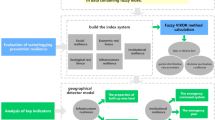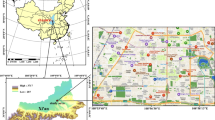Abstract
Improving natural disaster resilience is one of the important methods for coping with climate change and natural disasters, and quantitative evaluation of natural disaster resilience is the primary problem to be solved urgently. In this paper, an index system for evaluating regional flood disaster resilience is constructed based on a review of the literature regarding natural disaster resilience and with full consideration of the five dimensions (i.e., nature, society, economy, technology and management) which have a great influence on flood disaster resilience. Subsequently, the overall level and five dimensions of flood disaster resilience in the Chaohu Lake Basin can be evaluated quantitatively by adopting analytic network process to dynamically analyze the influencing relationships of factors. The results obtained in this research indicate that: (1) overall, the majority of the Chaohu Lake Basin exhibits intermediate to high flood disaster resilience, but there are distinct variations within the basin. The resilience is clearly influenced by the natural dimension indexes, the highest resilience levels are mainly located in the hilly, mountainous regions, and the lowest resilience levels mainly occur in the south–southeast plain of the Chaohu Lake Basin and the river estuary of the Chaohu Lake. Considering the administrative regions, the regions with the greatest areas of intermediate and high resilience are Hefei Municipal District, Chaohu City, Feidong County, Feixi County, Lujiang County, Hanshan County, Shucheng County, most parts of He County, Wuwei County and Jiujiang District of Wuhu City. (2) Preliminary validation indicates that evaluation results regarding flood disaster resilience in the Chaohu Lake Basin are consistent with the actual conditions. Therefore, the evaluation results and method can provide a valuable approach to the rapid diagnosis of weak links in the construction of flood disaster resilience infrastructure and will ultimately improve the level of flood disaster resilience in the Chaohu Lake Basin.







Similar content being viewed by others
References
Adger WN, Hughes TP, Folke C et al (2005) Social–ecological resilience to coastal disasters. Science 309(5737):1036–1039
Armaghan A-E, Reza K (2014) Evaluating the relative power of water users in inter-basin water transfer systems. Water Resour Manag 28(2):495–509
Asian Development Bank (2008) Managing Asian Cities: sustainable and inclusive urban solutions. Asian Development Bank, Tokyo, pp 89–92
Cannon T, Twigg J, Rowell J (2003) Social vulnerability, sustainable livelihoods and disasters: report to DFID Conflict and Humanitarian Assistance Department and Sustainable Livelihoods Support Office London: Natural Resources Institute, University of Greenwich, pp 78–84
Chan S-L, Wey W-M, Chang P-H (2014) Establishing disaster resilience indicators for Tan-sui river basin in Taiwan. Soc Indic Res 115:387–418
Cheng L, Li H (2005) Application of ANP in process models: an example of strategic partnering. Build Environ 42(1):278–287
Cheng XF, Hao DD, Han P et al (2014) Flood loss assessment in Chaohu Lake Basin based on grid data. Resour Environ Yangtze Basin 23(10):1480–1483 (in Chinese)
Cutter SL, Barnes L, Berry M et al (2008) A place-based model for understanding community resilience to natural disasters. Glob Environ Change 18:598–606
Fei X, Wen JH, Du S, Xu H et al (2014) Progress in research on natural disaster resilience. J Nat Disasters 23(6):20–31 (in Chinese)
FEMA (Federal Emergency Management Agency) (2003) Mitigation BCA Toolkit. Federal Emergency Washington DC, pp 56–64
Field CB, Stocker TF, Barros VR et al (2012) Managing the risks of extreme events and disasters to advance climate change adaptation: special report of the intergovernmental panel on climate change. Cambridge University Press, Cambridge
IPCC (Intergovernmental Panel on Climate Change) (2014) Climate change 2014: impacts, adaptation, and vulnerability. Cambridge University Press, Cambridge
Kang B, Lee S-J, Kang D-H, Kim Y-O (2007) A flood risk projection for Yongdam dam against future climate change. J Hydro-Environ Res 1(2):118–125
Liu J, Shi PJ, Ge Y et al (2006) The review of disaster resilience reseach. Adv Earth Sci 21(2):212–218 (in Chinese)
Mayunga JS (2007) Understanding and applying the concept of community disaster resilience: a capital-based approach. http://www.ehs.unu.edu/file/get/3761.Pdf. Accessed 21 Nov 2015
Mei P, Li GH, Lu S et al (2014) An analytic network process approach for rapid loss assessment of high casualty fires in China. Fire Technol 50(5):1163–1179
Mileti DS (1999) Disasters by design: a reassessment of natural hazards in the United States. Joseph Henry Press, Washington DC, pp 45–49
National Development and Reformation Committee (2013) National strategy of climate change adaptation. http://www.gov.cn/gzdt/att/att/site1/20131209/001e3741a2cc140f6a8701.pdf. Accessed 8 Dec 2015. (in Chinese)
Plough A, Fielding JE, Chandra A et al (2013) Building community disaster resilience: perspectives froa large urban county department of public health. Am J Public Health 103(7):1190–1197
Prashar SK, Shaw R (2012) Urbanization and hydro-meteorological disaster resilience: the case of Delhi. Int J Disaster Resil Built Environ 3(1):7–19
Saaty TL (1996) The analytic network process: decision making with dependence and feedback. RWS Publications, Pittsburgh
Shaw R, Fernandez G (2010) Urban risk management in South Asia. SAARC Disaster Management Centre (SDMC), New Delhi, pp 23–34
Shaw R, IEDM Team (2009) Climate disaster resilience: focus on coastal urban cities in Asia. International Environment and Disaster Management Lab, Kyoto University, Kyoto, p 4
UK Department for International Development (2011) Humanitarian emergency response review. UK Department for International Development
UNISDR (United Nations International Strategy for Disaster Reduction) (2009) Terminology on disaster risk reduction. UNISDR, Geneva, p 24
World Bank (2008a) World Development Report 2009: reshaping economic geography. World Bank, Washington DC, pp 73–78
World Bank (2008b) A primer on reducing vulnerabilities to climate change impacts and strengthening disaster risk management in East Asian Cities. The World Bank, Washington DC
World Economic Forum (2008) Building resilience to natural disasters: a framework for private sector engagement. World Economic Forum, Geneva, pp 10–11
Xu PP, Chan E (2013) ANP model for sustainable Building Energy Efficiency Retrofit (BEER) using Energy Performance Contracting (EPC) for hotel buildings in China. Habitat Int 37:104–112
Yuan Y, Wang XY, Li X et al (2007) Analysis of spatial and temporal characteristics of drought and flood in the Chaohu Lake Basin. Disaster Sci 22(2):97–100 (in Chinese)
Zhang L, Chen XH, Qian HS (2011) Diagnosis of resilience to flood hazard in lower reaches of the Beijiang River. J Hydraul Eng 42(9):1129–1134 (in Chinese)
Acknowledgments
This research is supported by the National Natural Science Foundation of China (Grant No. 41271516), the Anhui Normal University Graduate Student Research and Innovation Project (Grant No. 2014yks090).
Author information
Authors and Affiliations
Corresponding author
Rights and permissions
About this article
Cite this article
Sun, H., Cheng, X. & Dai, M. Regional flood disaster resilience evaluation based on analytic network process: a case study of the Chaohu Lake Basin, Anhui Province, China. Nat Hazards 82, 39–58 (2016). https://doi.org/10.1007/s11069-016-2178-3
Received:
Accepted:
Published:
Issue Date:
DOI: https://doi.org/10.1007/s11069-016-2178-3




